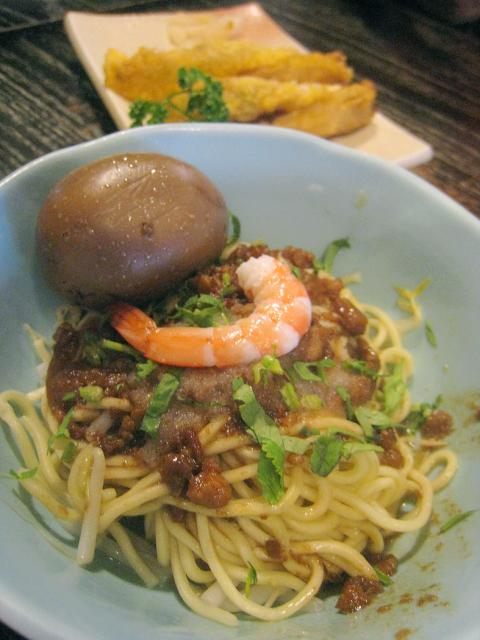Peddler’s noodles (擔仔麵, danzaimian) is a popular snack or supper food that can be found all around town, often in quite unremarkable versions of flabby noodles, watery soup and an over-seasoned meat sauce. Du Hsiao Yueh (度小月), which according to shop lore began business back in 1895, has had plenty of practice in getting it right. It has five outlets, including two in Tainan, its home city, and three in Taipei, with the newest restaurant in the bustling Yongkang Street (永康街) shopping district.
Du Hsiao Yueh’s Yongkang Branch has left its humble origins far behind, and while its minimalist contemporary Chinese interior is not exactly luxurious, it has some pretensions to style. The most notable aspect of the design is the replica low brick stall at the front where the noodles are made. A video screen above provides a detailed introduction to the store and the craft that goes into making the perfect bowl of peddler’s noodles.
A basic bowl of noodles, available either dry or in soup, is just NT$50. It is flavored by Du Hsiao Yueh’s special meat sauce, which has just the right amount of flavor, enhancing noodles that are cooked to al dente perfection. The yellow Taiwan noodles (油麵) are the traditional choice, but vermicelli (米粉) and flat rice noodles (粿條) are also available. Dry rice with meat sauce (祖傳肉燥飯) is available at NT$30 for a small bowl.

Photo: Ian Bartholomew, Taipei Times
Whether you choose the noodles or the rice, both are really not more than a few mouthfuls of food. Fortunately, Du Hsiao Yueh also offers a host of side dishes made in a kitchen in the back, lifting the humble bowl of noodles into a varied spread not unlike an Asian version of tapas.
The bowl of noodles can be enhance by a stewed duck egg (NT$15) and perhaps a side of deep fried shrimp rolls (NT$150, 黃金蝦捲) to make a perfect light snack. Served with a sweet dipping sauce, these crispy rolls are dangerously moreish, and are almost worth a visit to the restaurant all by themselves. But Du Hsiao Yueh offers much more.
For those who feel like taking a little time over their meal, there is a multi-page menu of side dishes that are likely to all but eclipse the central bowl of noodles. These range from the light-as-air deep fried tofu (炸芙蓉豆腐, NT$160) and delicately flavored vegetable dishes such as fresh harvested cold bamboo shoots (NT$200, 晨採關廟冷筍) to regular stir-fries like shrimp and cabbage (NT$180, 櫻花蝦炒高麗菜). Hawker stall favorites that are now sadly hard to find, such as Tainan-style taro cake (台南芋粿), are a welcome addition to the menu.
For those visiting Du Hsiao Yueh for an evening snack, the establishment also offers Taiwan Beer, two kinds of shaohsing wine (紹興酒) and two types of kaoliang (高粱酒) to help diners make a night of it.
Service, which is provided by by young people who are quick on their feet and able to lay out your spread of small dishes in record time, is fast and efficient. The staffers are not exactly founts of information about the food, but the picture menu does provide some explanation about each dish (in Chinese only).

Every now and then, it’s nice to just point somewhere on a map and head out with no plan. In Taiwan, where convenience reigns, food options are plentiful and people are generally friendly and helpful, this type of trip is that much easier to pull off. One day last November, a spur-of-the-moment day hike in the hills of Chiayi County turned into a surprisingly memorable experience that impressed on me once again how fortunate we all are to call this island home. The scenery I walked through that day — a mix of forest and farms reaching up into the clouds

With one week left until election day, the drama is high in the race for the Chinese Nationalist Party (KMT) chair. The race is still potentially wide open between the three frontrunners. The most accurate poll is done by Apollo Survey & Research Co (艾普羅民調公司), which was conducted a week and a half ago with two-thirds of the respondents party members, who are the only ones eligible to vote. For details on the candidates, check the Oct. 4 edition of this column, “A look at the KMT chair candidates” on page 12. The popular frontrunner was 56-year-old Cheng Li-wun (鄭麗文)

“How China Threatens to Force Taiwan Into a Total Blackout” screamed a Wall Street Journal (WSJ) headline last week, yet another of the endless clickbait examples of the energy threat via blockade that doesn’t exist. Since the headline is recycled, I will recycle the rebuttal: once industrial power demand collapses (there’s a blockade so trade is gone, remember?) “a handful of shops and factories could run for months on coal and renewables, as Ko Yun-ling (柯昀伶) and Chao Chia-wei (趙家緯) pointed out in a piece at Taiwan Insight earlier this year.” Sadly, the existence of these facts will not stop the

Oct. 13 to Oct. 19 When ordered to resign from her teaching position in June 1928 due to her husband’s anti-colonial activities, Lin Shih-hao (林氏好) refused to back down. The next day, she still showed up at Tainan Second Preschool, where she was warned that she would be fired if she didn’t comply. Lin continued to ignore the orders and was eventually let go without severance — even losing her pay for that month. Rather than despairing, she found a non-government job and even joined her husband Lu Ping-ting’s (盧丙丁) non-violent resistance and labor rights movements. When the government’s 1931 crackdown